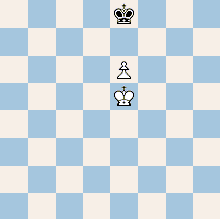 The king may, optionally, jump an extra square when castling. The rook ends up on its usual square.
The king may, optionally, jump an extra square when castling. The rook ends up on its usual square.
Introduction
The only difference between Castle Chess and regular chess is the extended castle rule. When castling the king may jump three squares, but it can also jump two as usual. The rook ends up on its usual square. This change greatly enlarges the opening tree as many more opening variations become practicable. The longer jump of the king is useful in most variants with queenside castle. At kingside castle, it is sometimes worthwhile to place the king on a more protected square. This ought to be useful, for instance, in King’s gambit variations. However, one must keep in mind that the king is removed farther from the centre, and the king no longer protects the vital f2/f7 square. Sometimes it’s better to castle normal. See also Adjutant Chess and Neoorthodox Chess.
 The king may, optionally, jump an extra square when castling. The rook ends up on its usual square.
The king may, optionally, jump an extra square when castling. The rook ends up on its usual square.
Discussion
I have studied much opening play, and I tend to get frustrated because less and less room is allowed for creativity. Spassky felt the same about opening play. It always leads to a draw, so one could just as well play rapidly and pragmatically, instead of being creative. He was thinking along such lines that fateful day when he declared that “this was my final King’s gambit” (after the draw against Ornstein). Opening play is today become a straightjacket. But wouldn’t it be fun to be able to play the Jänich gambit (in Ruy Lopez) as black? If a tiny rule change can infuse life into many opening systems, I see no reason we shouldn’t adopt it.
Obviously, if this little rule change could infuse new life into the King’s gambit, then chess would benefit greatly. Moreover, as classical games are fully compatible with the extended castle rule (one can still make classical castle), old master games are still relevant sources of study. Remember that there are obvious disadvantages with the long king jump. The king doesn’t defend the weak f2/f7 pawn, a cornered king runs a greater risk of mate, and the king is a longer way from the centre in the endgame.
There is a lopsidedness to today’s rules. In practice, queenside castle takes two moves, whereas kingside castle takes only one move. What’s the point in maintaining such an imparity? Why should kingside castle be favoured before queenside castle? Keep in mind that queenside castle is still harder to achieve while the queen must move away before castling. To move the queen early in the opening is controversial. Moreover, the queenside is a more dangerous place while the enemy queen is positioned there, and the enemy queenside pawns are more prone to pawn storms than the kingside pawns (i.e. it’s more dangerous to weaken the kingside pawn structure than to weaken the queenside).
But what would happen to the Sicilian Dragon? It would give white a tempo, which would probably prove disastrous for black, but only if black cannot make use of the kingside castle to the corner square. Nevertheless, this will not bring the Sicilian Dragon to its knees because black needn’t play the variation with 2…d6. He could play the 2…Nc6 system where white cannot castle on the queenside.
Moreover, many new Sicilian systems will become playable where white castles on the queenside, whereas black will avoid the Sicilian defenses that lead to a white advantage thanks to the extended castle. So the Sicilian will continue to live. Perhaps the Closed Sicilian will again rise to popularity, since white plays f4 in these systems.
Castle Chess with revised pawn
In an alternative variant the pawn, on the seventh rank, has an additional forward capture-capability. The revised pawn, provided that it has reached the seventh rank, can also capture forwards. Due to this, passed pawns are now more dangerous. In Castle Chess with revised pawn, drawish endgames will occur less often. Many theoretical endgames that have hitherto been drawn are now won. The additional capture-capability will also have an impact in the middlegame.
The pawn’s extra capture capability is a surprisingly simple way of introducing extra complexity. Comparatively, in orthodox chess a pawn is easy to block. This creates the marked drawishness of practical endgames. Therefore, most chessplayers prefer to keep the queen on the board, until they have created an advantage. Players can now exchange queen and enter a practical endgame, and, unlike before, the stronger player will tend to win. This is, arguably, a significant improvement compared with orthodox chess, although much analysis is needed to establish this. The new pawn is used in my Revised Chess (June 2009).
 Unlike in regular chess, this position is won regardless who makes the first move.
Unlike in regular chess, this position is won regardless who makes the first move.
☛ You can download my free Castle Chess program here, but you must own the software Zillions of Games to be able to run it. (I recommend the download version.)
☛ You can play Castle Chess (with revised pawn) against a human opponent, here.
☛ Don’t miss my other chess variants.
© Mats Winther, Jan 2011